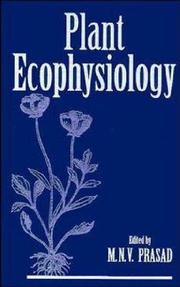| Listing 1 - 10 of 20 | << page >> |
Sort by
|

ISBN: 0849319641 Year: 2004 Publisher: Boca Raton CRC
Abstract | Keywords | Export | Availability | Bookmark
 Loading...
Loading...Choose an application
- Reference Manager
- EndNote
- RefWorks (Direct export to RefWorks)
Book
Year: 1989 Publisher: Taipei : Academia sinica, institute of botany,
Abstract | Keywords | Export | Availability | Bookmark
 Loading...
Loading...Choose an application
- Reference Manager
- EndNote
- RefWorks (Direct export to RefWorks)
TAIWAN --- BIOLOGICAL CONTROL --- ALLELOPATHY --- PEST RESISTANCE --- ALLOMONES --- INSECTS --- PHEROMONES --- MYCOTOXINS --- ALLELOCHEMICALS --- PHYTOCHEMICAL ECOLOGY --- MEETINGS
Book
ISBN: 9781578085774 Year: 2009 Publisher: Enfield : Science publishers,
Abstract | Keywords | Export | Availability | Bookmark
 Loading...
Loading...Choose an application
- Reference Manager
- EndNote
- RefWorks (Direct export to RefWorks)
plants --- tissue extracts --- Soil --- water --- Sampling --- Allelopathy --- Allelochemicals --- Analytical methods --- plant ecology --- Biological analysis
Book
Abstract | Keywords | Export | Availability | Bookmark
 Loading...
Loading...Choose an application
- Reference Manager
- EndNote
- RefWorks (Direct export to RefWorks)
Competitiveness describes a key ability important for plants to grow and survive abiotic and biotic stresses. Under optimal, but particularly under non-optimal conditions, plants compete for resources including nutrients, light, water, space, pollinators and other. Competition occurs above- and belowground. In resource-poor habitats, competition is generally considered to be more pronounced than in resource-rich habitats. Although competition occurs between different players within an ecosystem such as between plants and soil microorganisms, our topic focusses on plant-plant interactions and includes inter-specific competition between different species of similar and different life forms and intra-specific competition. Strategies for securing resources via spatial or temporal separation and different resource needs generally reduce competition. Increasingly important is the effect of invasive plants and subsequent decline in biodiversity and ecosystem function. Current knowledge and future climate predictions suggest that in some situations competition will be intensified with occurrence of increased abiotic (e.g. water and nutrient limitations) and biotic stresses (e.g. mass outbreak of insects), but competition might also decrease in situations where plant productivity and survival declines (e.g. habitats with degraded soils). Changing interactions, climate change and biological invasions place new challenges on ecosystems. Understanding processes and mechanisms that underlie the interactions between plants and environmental factors will aid predictions and intervention. There is much need to develop strategies to secure ecosystem services via primary productivity and to prevent the continued loss of biodiversity. This Research Topic provides an up-to-date account of knowledge on plant-plant interactions with a focus on identifying the mechanisms underpinning competitive ability. The Research Topic aims to showcase knowledge that links ecological relevance with physiological processes to better understanding plant and ecosystem function.
conservation --- Global Warming --- Climate Change --- invasion --- plant-plant interactions --- competition --- facilitation --- Allelochemicals
Book
Abstract | Keywords | Export | Availability | Bookmark
 Loading...
Loading...Choose an application
- Reference Manager
- EndNote
- RefWorks (Direct export to RefWorks)
Competitiveness describes a key ability important for plants to grow and survive abiotic and biotic stresses. Under optimal, but particularly under non-optimal conditions, plants compete for resources including nutrients, light, water, space, pollinators and other. Competition occurs above- and belowground. In resource-poor habitats, competition is generally considered to be more pronounced than in resource-rich habitats. Although competition occurs between different players within an ecosystem such as between plants and soil microorganisms, our topic focusses on plant-plant interactions and includes inter-specific competition between different species of similar and different life forms and intra-specific competition. Strategies for securing resources via spatial or temporal separation and different resource needs generally reduce competition. Increasingly important is the effect of invasive plants and subsequent decline in biodiversity and ecosystem function. Current knowledge and future climate predictions suggest that in some situations competition will be intensified with occurrence of increased abiotic (e.g. water and nutrient limitations) and biotic stresses (e.g. mass outbreak of insects), but competition might also decrease in situations where plant productivity and survival declines (e.g. habitats with degraded soils). Changing interactions, climate change and biological invasions place new challenges on ecosystems. Understanding processes and mechanisms that underlie the interactions between plants and environmental factors will aid predictions and intervention. There is much need to develop strategies to secure ecosystem services via primary productivity and to prevent the continued loss of biodiversity. This Research Topic provides an up-to-date account of knowledge on plant-plant interactions with a focus on identifying the mechanisms underpinning competitive ability. The Research Topic aims to showcase knowledge that links ecological relevance with physiological processes to better understanding plant and ecosystem function.
conservation --- Global Warming --- Climate Change --- invasion --- plant-plant interactions --- competition --- facilitation --- Allelochemicals
Book
Abstract | Keywords | Export | Availability | Bookmark
 Loading...
Loading...Choose an application
- Reference Manager
- EndNote
- RefWorks (Direct export to RefWorks)
Competitiveness describes a key ability important for plants to grow and survive abiotic and biotic stresses. Under optimal, but particularly under non-optimal conditions, plants compete for resources including nutrients, light, water, space, pollinators and other. Competition occurs above- and belowground. In resource-poor habitats, competition is generally considered to be more pronounced than in resource-rich habitats. Although competition occurs between different players within an ecosystem such as between plants and soil microorganisms, our topic focusses on plant-plant interactions and includes inter-specific competition between different species of similar and different life forms and intra-specific competition. Strategies for securing resources via spatial or temporal separation and different resource needs generally reduce competition. Increasingly important is the effect of invasive plants and subsequent decline in biodiversity and ecosystem function. Current knowledge and future climate predictions suggest that in some situations competition will be intensified with occurrence of increased abiotic (e.g. water and nutrient limitations) and biotic stresses (e.g. mass outbreak of insects), but competition might also decrease in situations where plant productivity and survival declines (e.g. habitats with degraded soils). Changing interactions, climate change and biological invasions place new challenges on ecosystems. Understanding processes and mechanisms that underlie the interactions between plants and environmental factors will aid predictions and intervention. There is much need to develop strategies to secure ecosystem services via primary productivity and to prevent the continued loss of biodiversity. This Research Topic provides an up-to-date account of knowledge on plant-plant interactions with a focus on identifying the mechanisms underpinning competitive ability. The Research Topic aims to showcase knowledge that links ecological relevance with physiological processes to better understanding plant and ecosystem function.
conservation --- Global Warming --- Climate Change --- invasion --- plant-plant interactions --- competition --- facilitation --- Allelochemicals
Dissertation
Year: 2011 Publisher: [S.l. : chez l'auteur],
Abstract | Keywords | Export | Availability | Bookmark
 Loading...
Loading...Choose an application
- Reference Manager
- EndNote
- RefWorks (Direct export to RefWorks)
Barley --- Hordeum vulgare --- Elateridae --- Coleoptera --- volatile compounds --- Larvae --- Root systems --- Alginates --- Communication between animals --- plant animal relations --- Allelochemicals --- Olfactométrie --- Pentylfurane

ISBN: 0849394694 Year: 1998 Publisher: Boca Raton, FL : CRC Press,
Abstract | Keywords | Export | Availability | Bookmark
 Loading...
Loading...Choose an application
- Reference Manager
- EndNote
- RefWorks (Direct export to RefWorks)
Allelochemicals. --- Allelopathic agents. --- Allelopathy. --- Drops. --- Multiphase flow. --- Particles. --- Plant chemical ecology. --- Plant-microbe relationships. --- Multiphase flow --- Drops --- Particles --- Écoulement polyphasique --- Gouttes --- Particules (matière) --- Écoulement polyphasique. --- Gouttes.

ISBN: 0471131571 Year: 1997 Publisher: New York John Wiley
Abstract | Keywords | Export | Availability | Bookmark
 Loading...
Loading...Choose an application
- Reference Manager
- EndNote
- RefWorks (Direct export to RefWorks)
ECO Ecology --- UVB radiation --- air pollution --- allelochemicals --- carbon dioxide --- drought stress --- ecology --- fire --- flooding --- freezing --- herbicides --- light --- metals --- plant ecophysiology --- polyamines --- radionuclides --- salt stress --- temperature
Book
ISBN: 0716750368 9780716750369 Year: 1992 Publisher: New York, NY : Scientific American Library,
Abstract | Keywords | Export | Availability | Bookmark
 Loading...
Loading...Choose an application
- Reference Manager
- EndNote
- RefWorks (Direct export to RefWorks)
Animal psychology and neurophysiology --- Feromonen --- Pheromones --- Pheromomes --- Chemoreceptor Cells --- Pheromones. --- 577.19 --- Hormones --- Semiochemicals --- Sex recognition (Zoology) --- Synomones --- Allelochemicals --- Allomones --- Ectohormones --- Kairomones --- Animal Communication --- Chemotactic Factors --- Pheromones and phytocins --- Internal medicine --- Physiology. --- Endocrinology --- Endocrinology. --- 577.19 Pheromones and phytocins --- Allelochemical --- Allomone --- Kairomone --- Pheromone --- Semiochemical
| Listing 1 - 10 of 20 | << page >> |
Sort by
|

 Search
Search Feedback
Feedback About
About Help
Help News
News